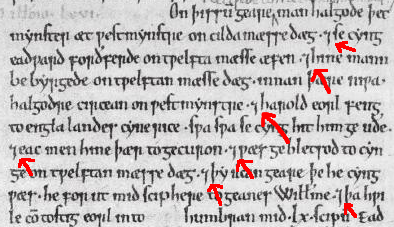According to A History of the English Language: Revised Edition by Elly van Gelderen, p.53, in Old English the numeral 7 was used as an abbreviation for the word and:
Abbreviations are frequently used, e.g. 7 stands for and …
The same book includes various Old English passages with examples of these 7's. The Peterborough version of the Anglo-Saxon Chronicle is reproduced on pages 83-84 alongside a Modern English translation, which the author has helpfully uploaded to their website:
An. M.LXVI. On þyssum geare man halgode þet mynster æt Westmynstre on Cyldamæsse dæg 7 se cyng Eadward forðferde on Twelfts mæsse æfen 7 hine mann bebyrgede on Twelftan mæssedæg innan þære niwa halgodre circean on Westmyntre 7 Harold eorl feng to Englalandes cynerice swa swa se cyng hit him geuðe 7 eac men hine þærto gecuron 7 wæs gebletsod to cynge on Twelftan mæssedæg 7 þa ylcan geare þe he cyng wæs he for ut mid sciphere togeanes Willelme ...
The author includes an image of this text on p.84, to which I've added some crudely drawn red arrows showing the locations of the putative 7's:
In the Modern English translation given by the author (by Benjamin Thorpe?), the 7's seem to correspond to and:
1066 In this year the monastery at Westminster was hallowed on Childermas day (28 December). And king Eadward died on Twelfth-mass eve (5 January) and he was buried on Twelfth-mass day, in the newly hallowed church at Westminster. And earl Harold succeeded to the Kingdom of England, as the king had granted it to him and men had also chosen him thereto and he was blessed as king on Twelfth-mass day. And in the same year that he was king he went out with a naval force against William ...
I'm curious about these 7's! I don't see any obvious relationship between the numeral 7 (or the word seofon) and the word and, and the book unfortunately doesn't elaborate.
Do we know how this convention came about? If so, how? Was it really the numeral 7 or just a similar-looking symbol?




